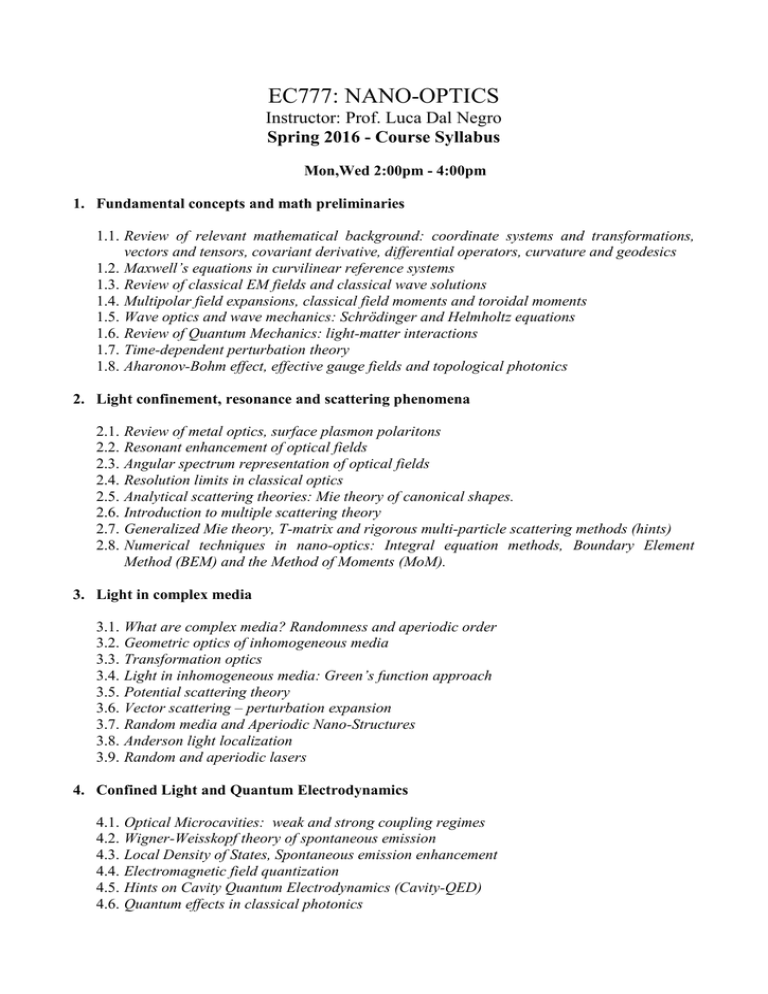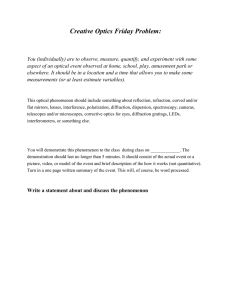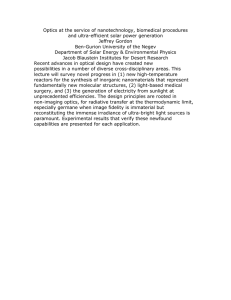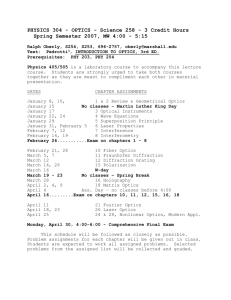SOLID STATE NANOPHOTONICS
advertisement

EC777: NANO-OPTICS Instructor: Prof. Luca Dal Negro Spring 2016 - Course Syllabus Mon,Wed 2:00pm - 4:00pm 1. Fundamental concepts and math preliminaries 1.1. Review of relevant mathematical background: coordinate systems and transformations, vectors and tensors, covariant derivative, differential operators, curvature and geodesics 1.2. Maxwell’s equations in curvilinear reference systems 1.3. Review of classical EM fields and classical wave solutions 1.4. Multipolar field expansions, classical field moments and toroidal moments 1.5. Wave optics and wave mechanics: Schrödinger and Helmholtz equations 1.6. Review of Quantum Mechanics: light-matter interactions 1.7. Time-dependent perturbation theory 1.8. Aharonov-Bohm effect, effective gauge fields and topological photonics 2. Light confinement, resonance and scattering phenomena 2.1. 2.2. 2.3. 2.4. 2.5. 2.6. 2.7. 2.8. Review of metal optics, surface plasmon polaritons Resonant enhancement of optical fields Angular spectrum representation of optical fields Resolution limits in classical optics Analytical scattering theories: Mie theory of canonical shapes. Introduction to multiple scattering theory Generalized Mie theory, T-matrix and rigorous multi-particle scattering methods (hints) Numerical techniques in nano-optics: Integral equation methods, Boundary Element Method (BEM) and the Method of Moments (MoM). 3. Light in complex media 3.1. 3.2. 3.3. 3.4. 3.5. 3.6. 3.7. 3.8. 3.9. What are complex media? Randomness and aperiodic order Geometric optics of inhomogeneous media Transformation optics Light in inhomogeneous media: Green’s function approach Potential scattering theory Vector scattering – perturbation expansion Random media and Aperiodic Nano-Structures Anderson light localization Random and aperiodic lasers 4. Confined Light and Quantum Electrodynamics 4.1. 4.2. 4.3. 4.4. 4.5. 4.6. Optical Microcavities: weak and strong coupling regimes Wigner-Weisskopf theory of spontaneous emission Local Density of States, Spontaneous emission enhancement Electromagnetic field quantization Hints on Cavity Quantum Electrodynamics (Cavity-QED) Quantum effects in classical photonics Topics for students’ projects and presentations 1. 2. 3. 4. 5. 6. 7. 8. 9. 10. 11. 12. 13. 14. 15. Near-field microscopy techniques Super-resolution imaging and super-lenses Optical metamaterials Optical nano-antennas Plasmonics technology Photonic bandgap structures: waveguides, membranes and resonators Photonic crystals LEDs, band-edge lasers Light localization and random lasers Enhanced solar cells Plasmonics light guiding elements, sensors and resonators Transformation optics and GRIN media optics Maxwell’s equations in curved spaces and GRIN optics Unruh effect, “optical black-holes”, perfect absorbers Toroidal moments electrodynamics Topological photonics Books: notes will be distributed by the instructor per each topic. No textbook needed. Suggested references: Principles of Nano-Optics (II Edition) by L. Novotny and B. Hecht (Cambridge) Theory and computation of electromagnetic fields by Jian-Ming Jin (Wiley) Scattering of electromagnetic waves (vol. 1-3) by L. Tsang, J. A. Kong, K. Ding (Wiley) Geometry and Light by U. Leonhardt and T. Philbin (Dover) Optics of Aperiodic Media, by L. Dal Negro (few chapters)



